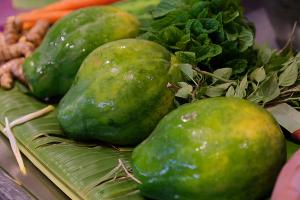UH/MAʻO Farms data show 60% improvement in diabetes risk
University of Hawaiʻi at MānoaData collected by the University of Hawai‘i at Mānoa and MA‘O Organic Farms, to capture the relationship between ‘āina (land/environment) and ola (health/life) from individuals living in Wai‘anae, show promise that getting a community involved in preventing type 2 diabetes can reduce their disease risk.
While scientists monitored health data from 392 people across Oʻahu, the majority lived in Waiʻanae, including 259 individuals of Native Hawaiian or Pacific Island ancestry—those at highest risk in Hawaiʻi for type 2 diabetes.
The UH study partnered with MAʻO Organic Farms in Waiʻanae, which provides educational and employment opportunities to young people in the area. These “interns” work the land and also receive tuition waivers. It is a program that the researchers and the community-based organization suspected would improve health among the interns, because they are active, working the land in ways their ancestors did, consuming healthier food—farm fresh—all while getting an education.
Many of the interns agreed to take part in the study, which measured body mass index, blood pressure, mental health, gut microbiome composition, diet, social economics, health behaviors and social network influences. It is among the interns that the preliminary results showed a 60 percent decline in risk for type 2 diabetes.
The study leaders are Alika Maunakea, a Waiʻanae-born associate professor at the John A. Burns School of Medicine (JABSOM), an expert in epigenetics (the molecular interaction between the environment and genes, and how changes in this interaction are involved in diseases that are disproportionately prevalent in Native Hawaiian and Pacific Island populations), and Ruben Juarez, an associate professor in the Department of Economics and UH Economic Research Organization. Juarez is a mathematical economist researcher with expertise in social networks and behavior.
“Studies like ours allow grassroot community-based organizations that do not explicitly target health, but definitely impact it, to be valuable partners in the healthcare system,” said Maunakea. “That enables sustainable health care by shifting the focus from treatment to prevention-oriented approaches in the real-world.”
Maunakea and Juarez hope by the study’s end they can develop new methodologies for communities to assess the impact of their programs in a rigorous scientific manner, or as they put it, “enable communities to play a vital role in the healthcare ecosystem.” The scientists also hope that, in the future, their study might be able to expand to other high-risk parts of the state.
Their overall aim is to collect data to capture the relationship between aina (land/environment) and ola (health/life) within social networks from individuals living in Waiʻanae. Waiʻanae and other communities where poor health is the highest in the state share some other factors associated with poor health: adults lacking a high school diploma, those 200 percent below the poverty level, those unemployed, those on food stamps, and those of Native Hawaiian/Pacific Island ancestry. However, these communities often are home to grassroot organizations, like MAʻO Organic Farms, that seek to mitigate these issues from a variety of holistic approaches and, in effect, can provide realistic solutions themselves to these unsustainable public health problems when enabled by evidence-based data of efficacy, as this study exemplifies.
The HMSA Foundation and Kamehameha Schools are sponsors of the research project.
For more information, visit: http://mauliolanetwork.com/

